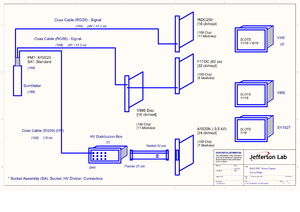Difference between revisions of "Time-of-Flight"
From GlueXWiki
(→TOF Studies) |
(→TOF Studies) |
||
| Line 28: | Line 28: | ||
*[[Track impact at TOF]] | *[[Track impact at TOF]] | ||
*[[Light Guide Design]] | *[[Light Guide Design]] | ||
| + | *[[Detector Rates and Lifetime]] | ||
===Organization=== | ===Organization=== | ||
Revision as of 08:34, 18 March 2011
The forward time-of-flight (TOF) detector is located right in front of the FCAL. It has two planes of scintillator paddles, in one plane the paddles are stacked vertically, in the other horizontally. Each paddle is 252cm long 6cm wide and 2.54cm thick. On both ends the paddles have "fish-tail" type light guides that couple to an XP2020 photo multiplier tube.
TOF Detector
The pupose of the TOF detector is to provide the means of particle identification (PID) through the measurement of the velocity of the particle passing through the detector volume. This velocity can be determined by measuring the time a particle needs for a given flight distance.
- GlueX doc 994 Conceptual design report of TOF
- TOF_PID
- Magnetic Field in region of TOF
Timing Resolution
Electronics
Nominal TOF electronics system diagram:Schedule
TOF Studies
- Photomultiplier Plateaus
- TDC histograms
- Photon conversion in the TOF
- Track impact at TOF
- Light Guide Design
- Detector Rates and Lifetime
